The Cross, or a Torturer's Stake? Why it matters.
A while back in my conversations with a Jehovah's Witness friend, my friend pointed out the "error" in all Bible Translations except their own New World Translation regarding Jesus dying on a cross. Rather, I was told, He died on a torturer's stake (Think: Single pole without a cross beam). At the time, I thought little of it and considered it to be nothing more than a minor point which didn't impact theology. At the time, I didn't realize the importance of this doctrine to the JWs. They are taught that the Cross is a pagan symbol that was not used by Christians until sometime around the 300s AD. The purpose of a JW bringing this up is to point out that they are correct regarding the Greek text and all Christians except them and all bibles except theirs are wrong. How can Christians be following the true God and true Gospel if they are worshiping at a pagan symbol? How can Christians have the true Bible if they are so wrong on such a basic point of translation? The implications are important because it is one of many false teachings that lock the JWs into the organization and into following exclusively the teachings of the group's governing body. Being taught that the cross is pagan instills a fear in JWs regarding following the True Christian religion because they see Christianity as rooted in paganism and its teachings being corrupted and blasphemous because of this pagan influence. This false doctrine is a stumbling block put into place by the governing body to keep JWs from listening to or believing true Christians.
As with many of the deceptions in this modern world, there is a point of corrupted truth in the doctrine. The Greek word in question is the word "σταυρός" or "stauros" (transliteration) (G4716 in Strong's). An upright stake, often pointed, such as used in a fence post has been a definition of this word. However, this was not the common use of the word at the time of the original Greek New Testament writings. The JWs have used an etymological fallacy to make their false point (an etymological fallacy is the faulty argument that the "true" or "proper" meaning of a word is its oldest or original meaning). Words and language change over time. From the modern day, look at the word "gay." I watch a lot of old tv shows and I can tell you this word was common back in the 50s and early 60s. The obvious meaning at the time had nothing to do with homosexuality. Another example is the word "consider." The original meaning was to "examine the stars." However, if I were to write today "you should consider the consequences of eating too much red meat" I would hope that future readers would not look back and say, "that man examined the stars at night to see if they would inform him regarding eating red meat." I would hope, instead, that they would consider how the word "consider" was used at the time of my writing (pun intended). To not do so would be an etymological fallacy. This is what the JW leadership has knowingly done with the word stauros.
In the Watchtower publication Insight on the Scriptures, Volume 1, the JW publishing body says the following on stauros, even quoting Greek sources:
Stau-ros' in both the classical Greek and Koine carries no thought of a "cross" made of two timbers. It means only an upright stake, pale, pile, or pole, as might be used for a fence, stockade or palisade. Says Douglas' New Bible Dictionary of 1985 under "Cross," page 253: "The Gk. word for 'cross' (stauros; verb stauroo...) means primarily an upright stake or beam, and secondarily a stake used as an instrument for punishment and execution."
As far as the Watchtower organization is concerned, the above quote is the beginning and end of it. However, if you actually look at Douglas' New Bible Dictionary, you will find more on the very same page the JWs selectively quote from:
The Gk. word for 'cross' (stauros; verb stauroo; Lat. crux, crucifigo) means primarily an upright stake or beam, and secondarily a stake used as an instrument for punishment and execution. It is used in this latter sense in the NT... Apart from the single upright post (crux simplex), on which the victim was tied or impaled, there were three types of cross. The crux commissa (St. Anthony's cross) was shaped like a capital T, thought by some to be derived from the symbol of the god Tammuz, the letter tau; the crux decussata (St. Andrew's cross) was shaped like the letter X; the crux immissa was the familiar two beams (✝, a picture of a traditional Christian cross appears here in the book), held by tradition to be the shape of the cross on which our Lord died (Irenaeus, Haer. 2.24.4). This is strengthened by the references in the four Gospels (Matthew 27:37Matthew 27:37 (KJV)
And set up over his head his accusation written, THIS IS JESUS THE KING OF THE JEWS. ; Mark 15:26Mark 15:26 (KJV)
And the superscription of his accusation was written over, THE KING OF THE JEWS. ; Luke 23:38Luke 23:38 (KJV)
And a superscription also was written over him in letters of Greek, and Latin, and Hebrew, THIS IS THE KING OF THE JEWS. ; John 19:19-22John 19:19-22 (KJV)
And Pilate wrote a title, and put it on the cross. And the writing was, JESUS OF NAZARETH THE KING OF THE JEWS. This title then read many of the Jews: for the place where Jesus was crucified was nigh to the city: and it was written in Hebrew, and Greek, and Latin. Then said the chief priests of the Jews to Pilate, Write not, The King of the Jews; but that he said, I am King of the Jews. Pilate answered, What I have written I have written. ) to the title nailed to the cross of Christ over his head.
Think about it. They very source the Watchtower quotes to support their point actually says a lot more than the Watchtower publishes. Specifically, the source leans towards the idea that Jesus was crucified on the crux immissa (a lower case "t" type cross), but the organization's followers never see that. As they do so often, the governing body selectively chooses a partial passage to support their point fully confident that their readers (the JWs) will not even go back to view the original source for themselves to see that they are being deceived and that the source was incorrectly used out of its true context as written by the original author. This is very common with all of the JW Greek suppositions.
The above is not the only example. The JW leadership has been at this for a while. In another example, the JW organization has also partially and selectively quoted from the Imperial Bible-Dictionary, published in 1866 by Fairbairn, Patrick (1805-1874), to make it look like this publication supports their false doctrine. Compare the JW quotation (note the ellipses) to the actual original article:
JW Publication:
"The Greek word rendered "cross" in many modern Bible versions ("torture stake" in NW) is stau·ros´. In classical Greek, this word meant merely an upright stake, or pale. Later it also came to be used for an execution stake having a crosspiece. The Imperial Bible-Dictionary acknowledges this, saying: "The Greek word for cross, [stau·ros´], properly signified a stake, an upright pole, or piece of paling, on which anything might be hung, or which might be used in impaling [fencing in] a piece of ground. . . . Even amongst the Romans the crux (from which our cross is derived) appears to have been originally an upright pole."-Edited by P. Fairbairn (London, 1874), Vol. I, p. 376." Reasoning from the Scriptures p.89
Patrick's original full unedited text (Notice how the JWs stop at a comma in the middle of a sentence in the original and end the thought with a period in their quotation):
"The Greek word for cross, (stauros), properly signified a stake, an upright pole, or piece of paling, on which anything might be hung, or which might be used in impaling (fencing in) a piece of ground. But a modification was introduced as the dominion and usages of Rome extended themselves through Greek-speaking countries. Even amongst the Romans, the crux (from which the word cross is derived) appears to have been originally an upright pole, and always remained the more prominent part. But from the time that it began to be used as an instrument of punishment, a traverse piece of wood was commonly added: not however always then. For it would seem that there were more kinds of death than one by the cross; this being sometimes accomplished by transfixing the criminal with a pole, which was run through his back and spine, and came out at his mouth. In another place Seneca mentions three different forms... "three crosses, not indeed of one sort, but fashioned in different ways; one sort suspending by the head persons bent towards the earth, others transfixing them through their secret parts, others extending their arms on a patibulum" There can be no doubt, however, that the later sort was the more common, and that about the period of the Gospel Age, crucifixion was usually accomplished by suspending the criminal on a cross piece of wood.
… But the commonest form, it is understood, was that in which the upright piece of wood was crossed by another near the top, but not precisely at it, the upright pole running above the other, thus "a cross" and so making four, not merely two right angles. It was on a cross of this form, according to the general voice of tradition, that our Lord suffered.
… It may be added that crucifixion was abolished around the time of Constantine, in consequence of the sacred associations which the cross had now gathered around it." -The Imperial Dictionary pp. 376-377
Again, the JW leaders have severely truncated an original publication to make it look as if the original author is supporting the JW's false doctrine. Again, even for books published in the middle 1800s, the JW leaders are brazen enough to trust that their followers will simply not read the original text from which they have quoted so that their purposeful deception is never uncovered.
In another example of deception, the JW governing body, in the Appendix to the 1950 and 1969 editions of The New World Translation and the Kingdom Interlinear reproduces a woodcut illustration by the 16th century artist Justus Lipsius of a stake, stating, "This is the manner in which Jesus was impaled." This gives the false impression that Lipsius supported the single pole stake as the method of Jesus' death. This is not true. Lipsius specifically taught that Jesus died on a cross. His book included a total of 16 woodcuts, nine depicting various forms of crucifixion. One of the crucifixion woodcuts which shows an actual Christian cross is inscribed in Latin with, "In the Lord's cross there were four pieces of wood, the upright beam, the crossbar, a tree trunk placed below, and the title placed above." - Lipsius states the exact opposite of what the JW organization claimed he taught and believed. Here is a picture, from the same book of woodcut illustrations, that shows the Christian cross with the inscription noted above.
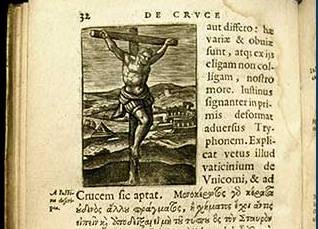
In desperation, The JW leadership has also quoted from very unreliable sources - sources they would never adhere to except to prove very isolated points. For example, the JW publication, Reasoning from the Scriptures references the book The Non-Christian Cross, by John Denham Parsons to support their point, yet I'm sure they would never reference him for anything else as Parsons was a non-believer and skeptic who also wrote Our Sun-God: Or Christianity before Christ, trying to prove a connection between Jesus and the Egyptian God Horus, and he was a member of the Society for Psychical Research to promote information on psychics and the paranormal. It is well documented that much of Parsons' research was deeply flawed - sometimes misquoting original authors as using words the original authors didn't even use.
JW leadership teaches that Christians didn't view Jesus on an actual cross until the third century, and before then, viewed him as being crucified on a torturer's stake, but there is clear evidence in ancient artwork that this is simply not the case. In a graffiti style drawing actually making fun of Christians from sometime between 80 and 200 AD, the Alexamenos Graffito shows a man with an donkey's head being crucified, to which a youth is raising his hand as if in prayer. The text in Greek reads: ALE XAMENOS SEBETE THEON which means, "Alexamenos worships his god." The idea of a God crucified on a cross was absurd in the eyes of pagans, thus the mockery of Christians and the cross in this image:
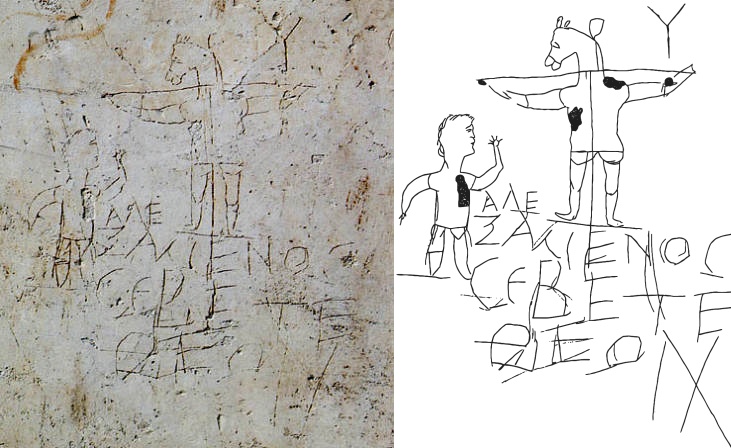
The point here is that the JWs are simply incorrect in their claim that the idea of the cross did not come into play until the third century. Archeological findings prove this out.
There are also pre-3rd century writings which disprove the JW's claim, clearly showing that the idea of the crossbeam existed long before the JWs state it came to be. For example, in the non-canonical Epistle of Barnabas, written between AD 70 and 132, it states:
Barnabas 12:2:
And He saith again in Moses, when war was waged against Israel by men of another nation, and that He might remind them when the war was waged against them that for their sins they were delivered unto death; the Spirit saith to the heart of Moses, that he should make a type of the cross and of Him that was to suffer, that unless, saith He, they shall set their hope on Him, war shall be waged against them for ever. Moses therefore pileth arms one upon another in the midst of the encounter, and standing on higher ground than any he stretched out his hands, and so Israel was again victorious. Then, whenever he lowered them, they were slain with the sword.
Here, Barnabas is equating Moses' stretching out his hands over Israel to Jesus stretching out his hands on the cross, an idea present within the very generation of Christ. This is an idea that would not be possible if Jesus were somehow attached to only a single upright pole, as the JWs claim.
Justin Martyr, a Christian apologist from the second century AD also specifically describes the two beams of the cross. In the First Apology Chapter XXXV Justin's description shows that Jesus dying on a cross was in fulfilment of prophecies that said he would 'spread out his hands' and also that he would bear God's Kingdom 'on his shoulders';
There are the following predictions:--"Unto us a child is born, and unto us a young man is given, and the government shall be upon His shoulders;" which is significant of the power of the cross, for to it, when He was crucified, He applied His shoulders, as shall be more clearly made out in the ensuing discourse. And again the same prophet Isaiah, being inspired by the prophetic Spirit, said, "I have spread out my hands to a disobedient and gainsaying people, to those who walk in a way that is not good. They now ask of me judgment, and dare to draw near to God." And again in other words, through another prophet, He says, "They pierced My hands and My feet, and for My vesture they cast lots." And indeed David, the king and prophet, who uttered these things, suffered none of them; but Jesus Christ stretched forth His hands, being crucified by the Jews speaking against Him, and denying that He was the Christ.
One great proof that Jesus has always been seen as having been crucified on an actual Christian cross comes from some of the earliest Christian gospel manuscripts known to exist. In early Christian writings, rather than using the Greek word stauros, scribes would use the staurogram, which removes all but two Greek letters from the word for the cross and instead uses only the remaining tau and rho as stand-ins for the full word. Staurograms serve as the earliest images of Jesus on the cross, predating other Christian crucifixion imagery by 200 years.
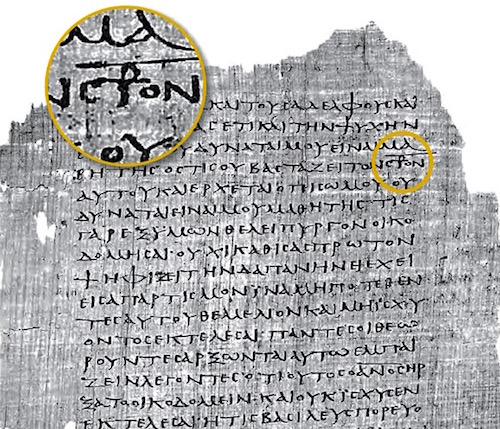
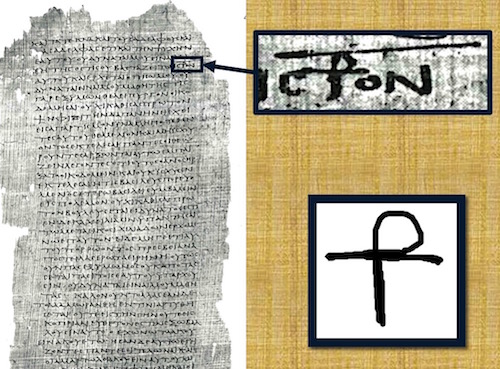
As can be seen in the images above, the tau looks similar to the English capital T and the rho looks similar to the English capital P. If you superimpose them, it appears as the cross, with the head of Jesus at the top.
Archaeological finds from the first century AD show the sign of the cross near the entrance of catacombs used by the very first christians in Jerusalem (see Jerusalem Christian Review, Volume 9, Internet Edition, Issue 2 "Jerusalem Burial Cave Reveals: Names, Testimonies of First Christians" Jean Gilman. - http://leaderu.com/theology/burialcave.html as of 10/18/2020)
The evidence is overwhelming. Christianity doesn't really have a lot riding on the shape of the cross, but for the Jehovah's Witnesses, they have everything riding on the shape of the cross, and the evidence bears out that they have been lied to. For JWs, the shape of the cross falsely ties all non-JW Christian faiths to paganism and falsely discredits the true accuracy of all other scriptural translations and points to the correctness of theirs. But what it really does is the opposite. Upon realizing that Jesus died on an actual Christian cross, as born out by history, so much of what JWs believe begins to fall apart.
Early editions (1950 and 1969) of the New World Translation said, “The evidence is, therefore, completely lacking that Jesus Christ was crucified on two pieces of timber placed at right angles…. The passing of time and further archaeological discoveries will be certain to prove its [torture stake] correctness.” -The Kingdom Interlinear Translation of the Greek Scriptures, (Brooklyn, New York: Watchtower Bible and Tract Society, 1969): 1157. In later editions of the same appendix, the Society discontinued the claim that archaeology would vindicate their claim. They've known the claim isn't supportable for at least 35 years.
It's interesting that even the Jehovah's Witnesses believed Jesus died on the Christian cross prior to October, 1931. They even had crosses on their literature, as shown in this Watch Tower from 1912
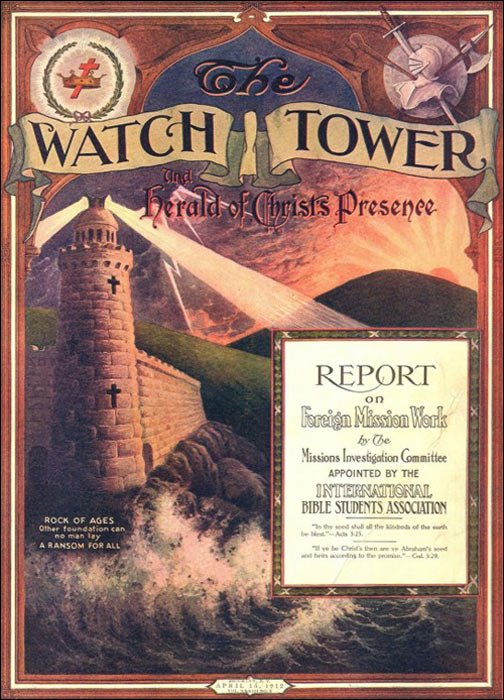
The Watchtower also represented Jesus' death on a cross in Russell's 1914 motion picture, The Photo Drama of Creation, slide 65.
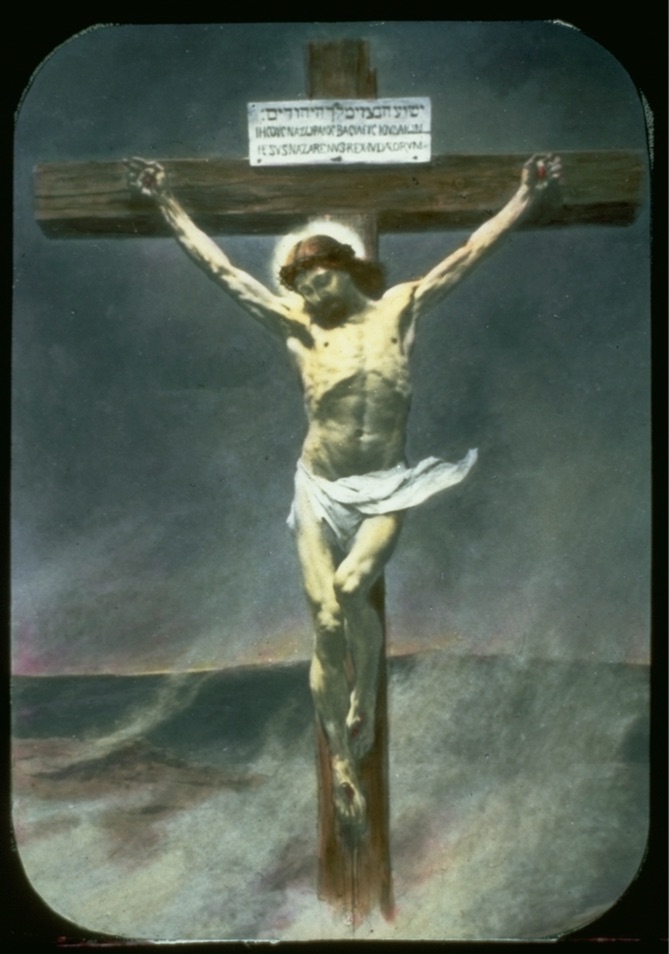
In their publication Life, from 1929, page 216 we read "Jesus was crucified upon the cross."
Following poorly researched and incorrect history available in 1936, it was formalized by the Watchtower organization that Jesus had not died on a cross. At the time, the elder Rutherford relied on incorrect information that has since been proven untrue by continuing history and discovery, to seize upon something that would differentiate his beliefs from those around him. Eighty-five years later, the governing body is embedded too deep with the falsehood to escape.
What's amazing is that previous to this Rutherford wrote "The cross of Christ is the greatest pivotal truth of the divine arrangement, from which radiate the hopes of men." -The Harp of God (Rutherford) p.141
So now, the JW governing body pictures Jesus on a torturer's stake, with a single nail through both of his hands. Yet John 20:25 says
Unless I see in his hands the print of the nails and stick my finger into the print of the nails and stick my hand into his side, I will never believe it.” (NWT as of October, 2020).
Even their version of this text admits that there were multiple nails - one for each hand because they were stretched out on the cross beam. The noun for nails is indeed plural in the Greek.
Matthew 27:37 also supports the idea of a cross rather than a stake when it says:
They also posted above his head the charge against him, in writing: “This is Jesus the King of the Jews.”" (NWT as of October, 2020).
If the JW doctrine were correct and the words of Matthew were indeed inspired by the Holy Spirit of God, should it have not been written, "They also posted over his hands..."?
What's sad is that this deception has been made to scare JWs away from the "pagan" Christian faith. Even if the cross has been used by pagan groups does not mean Christians are using the cross for pagan purposes. Wedding rings have been used by pagan groups, but no one would claim that when a Jehovah's Witness wears a wedding ring they have agreed to and participated in a pagan ritual. It is the same with the cross. The fear is unfounded. The argument is fallacious. Cats were worshiped as gods by the Egyptians, but having a cat does not equate to having invited a pagan god into your life today. Christians look to the cross in celebration (they do not worship the cross). As Paul said "But far be it from me to boast except in the cross of our Lord Jesus Christ..." (Galatians 6:14 - it's interesting to note here that in the NWT the JWs add the word "torture" to say "torture stake" even though the Greek merely says "en stauros" or "in the cross") and "For I decided to know nothing among you except Jesus Christ and him crucified." (1 Corinthians 2:2). To a Christian, what Jesus did at the cross is everything. It is the way by which we have gone from death to life. It is why we can be forgiven. It is why we will spend eternity in His glorious presence. We need to do nothing more because Jesus did everything at the cross.
If the Watchtower organization is going to reject symbols on the grounds of pagan roots, they need look no further than their own torturer's stake. Jesus death on a stake mimics the ancient Sumerian myth of Inanna. Inanna descended into the nether world where she was turned into a corpse by the seven judges and "the corpse was hung from a stake" for three days and nights. After this she was resurrected by the instructions of Enki, the god of fertility. (The Hero with a Thousand Faces, Joseph Campbell, 1973, and also Mythology A Visual Encyclopedia, Jo Forty 1999)
Further, the term "Watchtower" is a Wiccan term. The Guardians of the Watchtower represent the four elements (air, fire, water and earth) invoked during ritual to cast the magic circle. (See The Complete Idiot's Guide to Wicca and Witchcraft, D. Zimmerman, 3rd Edition p.187) "Watchtower" tablets are used in Enochian magic, developed by John Dee and Edward Kelley in the 16th century and furthered in popularity by the occultist Alistair Crowley in the 19th century. "The Watchtower structure is probably the most familiar part of Enochian magick. It has been popularized by the Golden Dawn and its descendants." (System of Enochian Magick, February 17, 2016) It is used in the act of calling upon or summoning a demon.
Arguments against Christianity that use pagan symbols and pagan holidays to prove an apostate nature must apply just as well to the Watchtower society. They can't pick and choose which pagan symbols matter when their very name and the stake on which their Jesus died are born in occult based magic and pagan histories.
Biblical Standards for Prophecy The Lord's Prayer for our Nation
